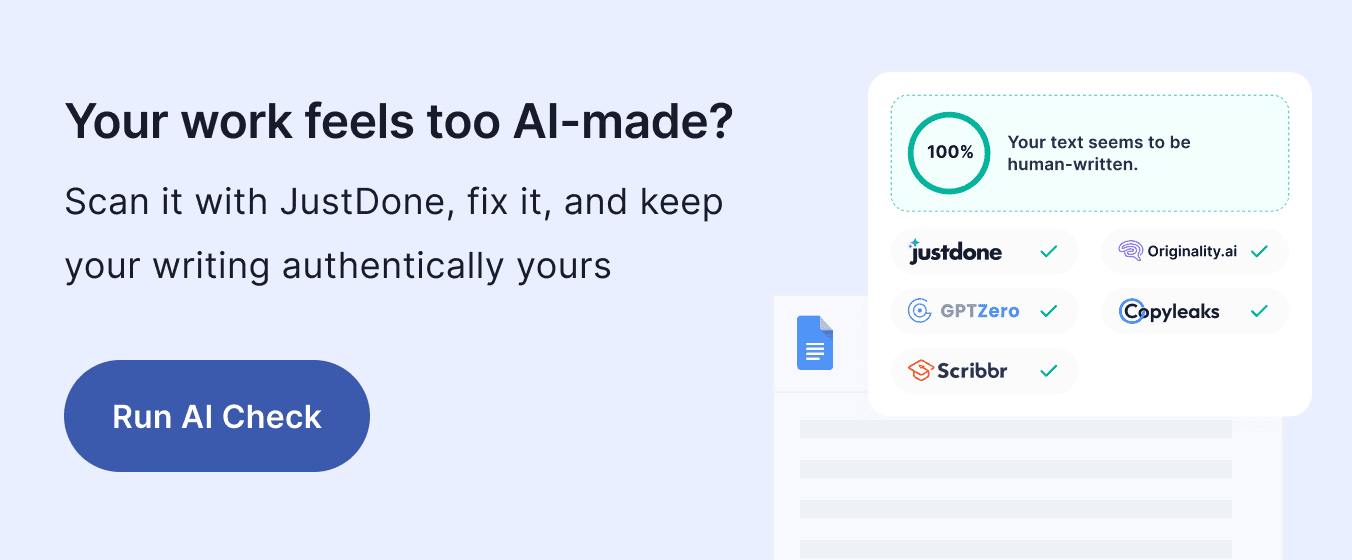With more students turning to ChatGPT, including GPT-4 and GPT-5.0, and Bard for help with essays, research, and brainstorming, it's no surprise that AI detection is becoming a hot topic. Can your professor or even an online detector spot if AI had a hand in your work? Which detection tools are most accurate? And if you’re using AI in a responsible way, how can you make sure your writing still comes across as authentically yours?
In this guide, we’ll take a look at how GPT detection works, which tools are best at spotting AI-generated content, and how you can stay on the safe side without losing the benefits of AI assistance. Whether you're refining a paper with ChatGPT or using Bard to explore new ideas, understanding detection tools is a smart move.

What Is GPT Detection?
GPT detection is the way to determine whether a piece of writing was generated by an AI language model like ChatGPT, GPT-4, GPT-5.0, or Bard. AI detectors analyze patterns in your text, like predictability, sentence length, vocabulary variation, and repetitiveness, to guess whether a human or a machine wrote it.
Some tools give you a probability AI score. Others simply say "AI-generated" or "Human-written." But none are perfect, and many can misidentify human writing as AI or vice versa.
If you're a student, this matters because you might get flagged unfairly even when you've written something yourself. Besides, if you're using AI ethically (for brainstorming or outlining), your final draft could still get flagged.
That’s why it’s important to understand both how these tools work and how to make your writing more authentically human.
Which Tools Detect GPT-4, GPT-5.0, ChatGPT, and Bard Most Accurately?
Not all AI detectors are created equal. Some tools struggle to detect GPT-4 because it's much better at mimicking natural human writing than earlier models.
Here’s a breakdown of how common tools perform when detecting modern LLMs (large language models):
| Tool | Best For | Strengths | Weaknesses | GPT-4 Detection Accuracy |
|---|---|---|---|---|
| JustDone AI Detector | Student writing | Designed for academic tone; clear feedback | May be sensitive to overly formal edits | High |
| GPTZero | Schools and educators | Balanced detection; lower false positive rate | May flag complex human writing | High |
| Originality.AI | Web publishers | Strong with GPT-3.5 and Bard detection | Less effective on GPT-4 and 5.0 + edited drafts | Medium |
| CopyLeaks | Academic writing | Tracks tone shifts and phrasing changes | Can overestimate AI in polished work | Medium-High |
| Writer AI Detector | Quick checks | Simple and fast | Struggles with nuanced or GPT-4 and 5.0text | Low-Medium |
The short version? GPT-4 and GPT-5.0 are harder to detect than GPT-3 or Bard, and your editing skills can make a big difference.
I recommend you use JustDone’s AI Detector as your go-to first check. It’s designed with student use cases in mind and helps you understand what to change to make your writing feel more natural. Here's what the results of AI detection will look like in JustDone:

Can ChatGPT-4 and GPT-5.0 Be Detected?
Yes, but not always. GPT-4 and GPT-5.0 are advanced enough so that with thoughtful prompting and careful editing, their outputs often pass as human-written.
However, many detection tools are still being trained on previous GPT patterns. This means GPT-4 and GPT-5.0 text, especially if slightly humanized, can slip past them.
If you’re worried about detection, it’s absolutely ok. Many students ask: "How to pass AI detection with ChatGPT?"
The answer is to blend AI support with your own voice.
Practical Prompts to Avoid GPT Detection
These original prompts are designed to help students learn how to bypass AI detectors with ChatGPT, GPT-4, or GPT-5.0 while reducing detection risk. Always rewrite and review AI content before submitting it.
Prompt 1: Emphasize voice and variation
“Help me write a paragraph on [topic] that sounds like a university student. Use informal transitions, slight inconsistencies in rhythm, and vary sentence length.”Prompt 2: Add personal context
“Give me a rough draft for a discussion post about [topic], including first-person reflections, some minor hedging, and occasional filler words.”Prompt 3: Include questions and uncertainties
“Write an opinion piece on [topic] that includes rhetorical questions, doubts, and moments of self-reflection to sound more human.”Prompt 4: Mix styles intentionally
“Draft an essay intro that combines formal and casual tone, mimics natural human pacing, and includes a few imperfect phrasings.”Prompt 5: Create errors on purpose
“Write this paragraph with a few minor grammatical slips, like extra commas or slight awkward phrasing, as if a student were writing under time pressure.”How to Pass AI Detection with ChatGPT: Humanize Your Draft
Once you get a draft from ChatGPT or Bard, don’t submit it directly. Instead, try to rewrite with your voice and add your own experiences, class references, and natural phrasing.
I recommend using a paraphraser or humanizer tool. JustDone has a dedicated paraphraser that helps rework AI text without losing meaning.
Then, run it through an AI detector before submitting. Make stylistic edits or use AI humanizer if you're flagged with a lot of AI-generated content.
This tool helps you vary your sentence length, use more human-sounding language, and break up patterns that sound too perfect or robotic.
Final Thoughts: Why GPT Detection Matters
AI detection tools are here to stay, and they’re improving. But they’re not perfect. As a student, you don’t have to fear using ChatGPT, GPT-4, GPT-5.0, or Bard. You just need to use them responsibly and make sure your final draft reflects your authentic voice.
Remember to blend AI help with personal insight, humanize your content with specific prompts, and use detection tools like JustDone’s AI Detector to test your work. In fact, when you understand how GPT detection works, you can use AI smarter, not sneakier.